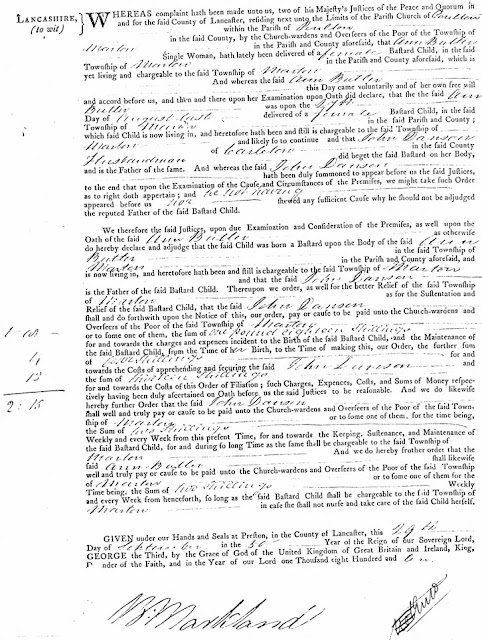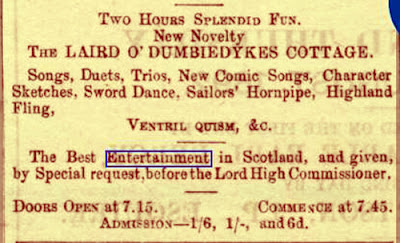My Theme for the A-Z Challenge 2023
Family Traits, Quirks and Characteristics
Family Traits, Quirks and Characteristics
U for UNETHICAL
Two tales of UNETHICAL behavior (in the conventions of the times) -
fathering a "bastard child" and conducting a secret marriage to an heiress.

John Danson, the eldest son of my great, great, great grandparents - Henry Danson and
Elizabeth Brown of Carleton, Lancashire, was the Black Sheep of my Danson family - as evidenced in this document which I was delighted to find at at Lancashire Record Office.
For John, in 1810 at the age of 21, was served with an affiliation
order ordering him to contribute to the upkeep of his “said bastard
child” - a daughter by Ann Butler of Marton. The poor child was repeatedly given this tag in the document below which is fascinating on its choice of language:
“Ann Butler, single woman, was upon the 27th
day of August last, delivered of a female bastard child in the said
township of Marton…and that John Danson, husbandman of Carleton did
begot the said bastard on her body and is the father of the same.
Thereupon,
we order… for the better relief of the said township…and the sustenance
and relief of the said bastard child…John Danson pay unto the
churchwardens and Overseers of the Poor…the sum of One Pound Eighteen
Shillings for and towards the charges and expenses incident to the
birth…further sum of four shillings towards the cost of apprehending and
securing the said John Danson….the sum of Two Shillings weekly…towards
the keeping, sustenance and maintenance of the said bastard child”.
In 1810, £1 18s 0d would have the same spending power of today's £131. with 2s 0d being worth today £6.88 - not much for bringing up a child! (http://www.measuringworth.com)
Unfortunately
I have been unable to trace anything further on this story. A search
for an Ann butler brought no results - she could well have married and
be known by a different name. John
Danson died in 1836, aged 46, as far as I know unmarried, and he
predeceased
his father Henry by three years.
**********************
"Butler's Secret Marriage to an Heiress" was the headline when this Downtown Abbey style story came to be revealed.
It came to light when a cousin asked me to help trace information
about his maternal grandmother Sarah Haydon Lounds who married my great
uncle John Danson (below). My cousin knew very little apart from the fact the family came from Lincolnshire/Nottinham shire area and there was a scandal involving a Henry Lounds who worked as a butler in a large house.

Using standard online resources, I traced Sarah''s father to be George Haydon Lounds and her brother Haydon Lounds (1873-1947) who was named after his grandfather - another Haydon Lounds, a coach builder in Grantham, Lincolnshire. The Haydon name came from two generation further back when in 1814 a Thomas Lounds married a Sarah Haydon. The name Haydon was passed down through many generations and branches of the family.
I
was grateful to an internet contact for filling me in with details
on this "black sheep" of the family.
For it came
to light that butler Haydon Lounds had secretly married heiress Miss
Maud Ward Fox - the daughter of his employer, a wealthy widow.
On her death in 1911 Mrs Eleanor Ward-Fox left in her will £13,000 to her daughter, Maud, with a legacy of £200 to "my butler Lounds in my service at my death". (. £. In today’s money terms)
A Secret Marriage Ceremony in 1909: However
not known at the time of Mrs Ward-Fox's death was the fact that butler
Haydon Lounds, "a good looking and well educated man", according to a
newspaper report, had been for three years the husband of Maud,
following a secret marriage ceremony in Devon in 1909. The online
Index to marriages confirms this event.
Single in the Census of 1911: But in the 1911 census Haydon was still describing himself as single - a 38 year old bachelor, still working as a butler for the Ward-Fox family - Mrs Eleanor Ward-Fox, her older daughter Gertrude and Maud, 30, (also cited in the census as single) all living at Bramhope, Torquay in a household that included a footman, groom, cook, kitchen maid and two housemaids. Mrs Ward Fox died later that year at the main family home in Bakewell, Derbyshire.
Change of Name: The wedding was kept a secret for three years and was first reported in the then "Morning Post" Feb 9th 1912 when Haydon changed his surname by deed poll to Haydon Stephen-Fox.
No children were born to the marriage, with Maud dying 1945
and Haydon two years later.
*********************
Onto V for VALIANT

IN CASE YOU MISSED
A for ADVENTUROUS, B for BIGAMOUS, C for CRIMINAL, D for DEVOUT
E for ENTERPRISING & ESTEEMED, F for FEISTY















